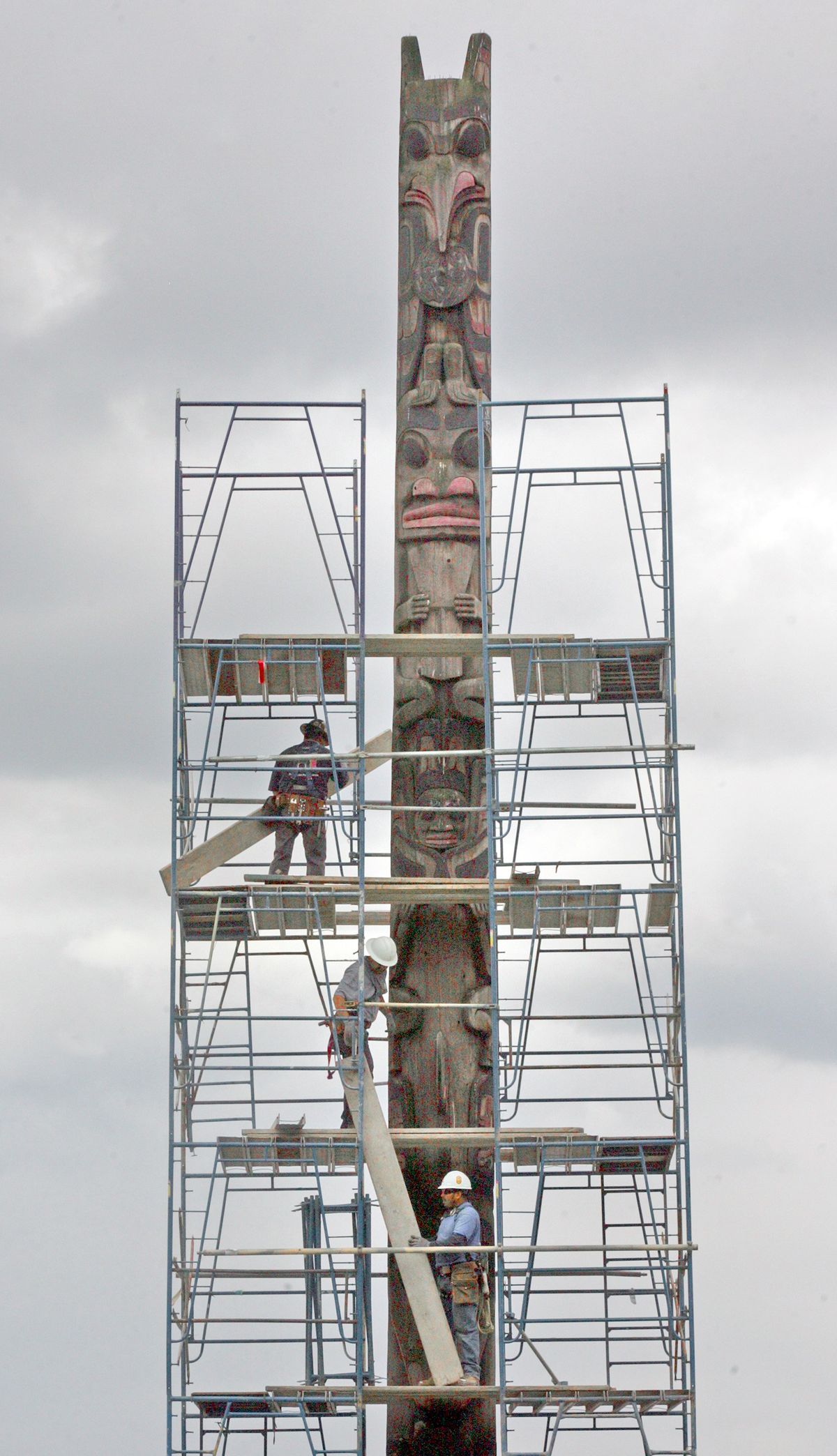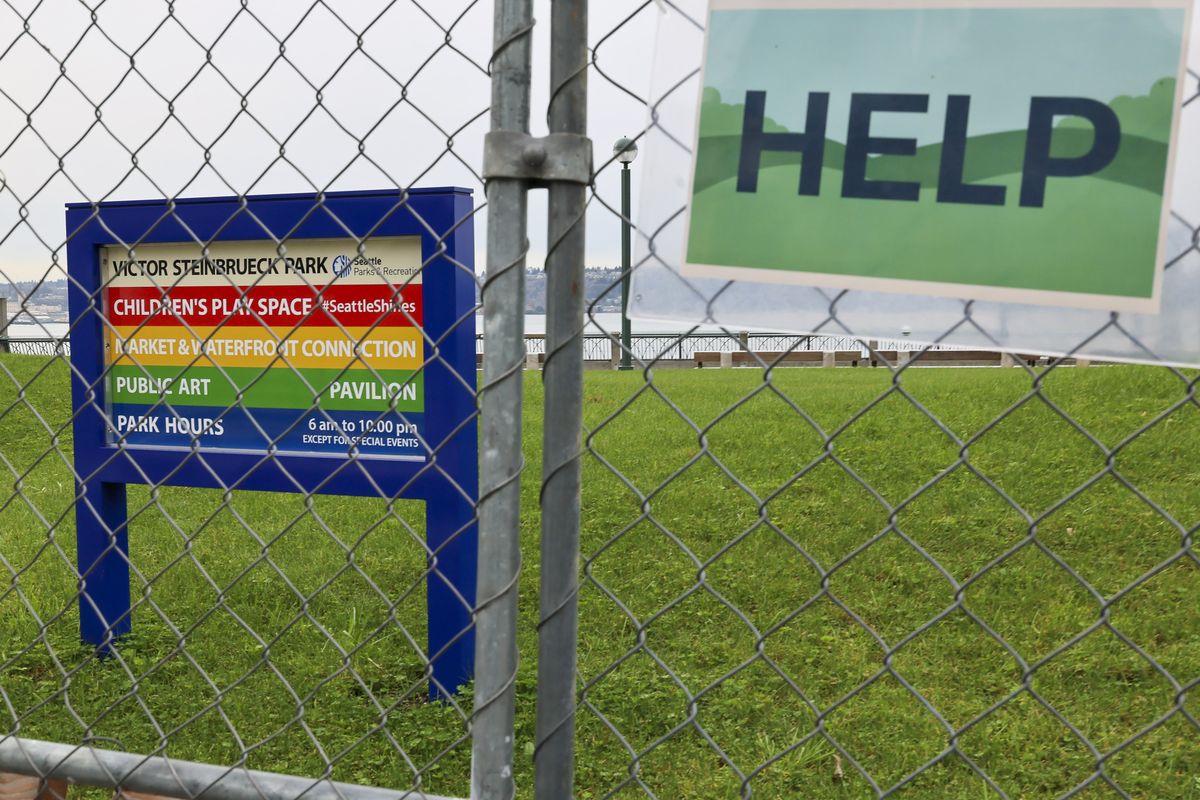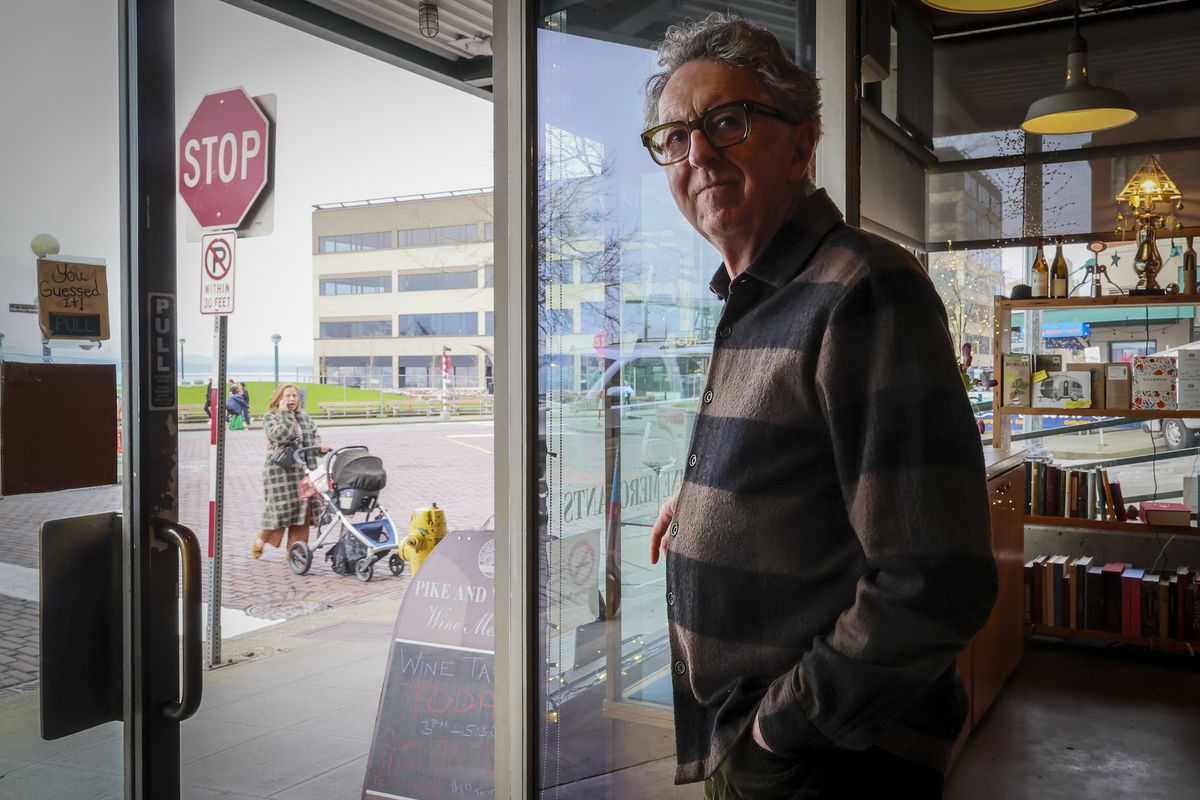Park at Seattle’s Pike Place Market stuck in totem pole standoff
Victor Steinbrueck Park, photographed Friday morning, is closed despite being finished and is fenced off because of a lack of the former totem poles. (Kevin Clark/The Seattle Times/TNS)
SEATTLE – In 2019, the Pike Place Market Historic Commission gave the green light to renovate Victor Steinbrueck Park – the grassy overlook area at the north end of the market. The park needed a complete overhaul to repair a degrading membrane between its grass hills and the parking garage below.
Five and a half years later, the work is finished and yet the park remains shuttered. Even as new additions to the market and the waterfront below have come to life, the famed Seattle overlook remains caught in a standoff between Seattle Parks and Recreation and the historic commission.
At issue: the state of the park’s totem poles.
The poles were removed for the renovation and needed their own restoration. They’re stored by the Parks Department at Fort Lawton, near Discovery Park. The commission, which reviews nearly every change made to Pike Place Market, has insisted from day one that the park cannot reopen without them.
But over the course of the park’s renovations, the two sides fell into a fight, first, over whether the poles might be replaced and, second, over the proper way to restore them.
The back and forth has become heated at times, at one point going before Seattle’s hearing examiner. Commissioners have accused the city of mishandling the poles and allowing them to degrade, while Seattle Parks insists it’s taking the necessary steps to chart a path forward.
All the while, the park has stayed fenced to the public, well beyond the city’s original April 2024 target.
As nearby businesses have grown frustrated with the standoff, Mayor Bruce Harrell is now saying he will reopen the park in March, before the poles have been fully refurbished. The park’s continued closure has been a hiccup in the city’s grand plans for a connected waterfront and Market, and Harrell said the poles would return after it has reopened. The decision is ultimately that of Seattle Parks and Recreation, Harrell spokesperson Callie Craighead said.
“While we appreciate the input of the Historical Commission and believe we have worked with them in good faith to show that we will restore and reinstall the poles, it’s approaching time to reopen this public park,” she said. “We will submit another request to the commission while the pole restoration work is underway, but, ultimately, the City’s Parks Department retains the authority to reopen the park.”
Harrell’s plan could set up another fight. The commission, which takes its job of market preservation extremely seriously, has claimed authority over the park’s opening and says it won’t budge until it’s convinced there’s a binding plan for the poles’ restoration and return. To do otherwise would be, in their view, an abrogation of their duty to protect the market.
Seattle Parks and Recreation and the mayor know what they need to do to win approval to open the park, Commissioner Sam Farrazaino said, pointing to the city code regulating the commission. “If our Mayor and City Departments do not follow the law, I am not sure why anyone else would,” he said.
Debate over authenticityThe park’s two poles – the Farmer’s Pole and the Untitled Totem Pole – were installed in 1984, when it was known just as Market Park.
Designed by Marvin Oliver of the Quinault tribe, they were carved with the help of a white man, James Bender. In the years since they were erected, the park was renamed after Victor Steinbrueck, who’s credited with saving the market from redevelopment. Until their removal in 2023, the poles marked the northern end of Pike Place Market – their back to Puget Sound, sentinels over the shoppers below.
In 2018, several prominent Native voices in Seattle – Colleen Echohawk and former Seattle City Councilmember Debora Juarez – began questioning the poles’ place in the park. They said they did not represent the more local Native art forms and argued that “welcome poles” – single figures with their arms stretched out – were more typical wood sculptures in the area.
The historic commission, however, held firm that the park should reopen exactly as it was before the renovations. In this context, they drafted their policy stating the park could only open upon the original poles’ return.
“It’s the job of the commission to protect the authenticity of the use of the market and also the design,” said Christine Vaughan, a former member of the commission. “These poles are representative of a particular time of Seattle’s history.”
The park’s restoration was delayed for several years by the COVID pandemic. Construction began in late 2022.
As crews finally took down the poles, they found them to have degraded around their base. Rotting wood flaked off in large chunks and the bottom ends were pulpy.
The parks department moved them to Fort Lawton. There, they were laid down, outside. Seattle Parks saw no problem with this, considering they’d been outside for 40 years prior, but the storage nevertheless frustrated the commission.
“If you walked in there you would think they were in a morgue,” David Steinbrueck, Victor Steinbrueck’s son, said of their storage.
Craighead from the mayor’s office said, “The city has taken careful steps to ensure the poles are restored properly, while completing all the other renovations of this special park.”
In 2024, the city told the commission it was interested in replacing the poles with a different, unspecified piece of Native art – reigniting the debate over authenticity that had died down in the years before.
The commission said no, pointing to their original edict. The city took the question to a hearing examiner, who dismissed the appeal.
As the fight dragged on, so too did the park’s closure.
Restoration or reworkWith it clear that the poles would return, the next fight began: how they should be restored and by whom.
Hanging over the process is the question of what constitutes maintenance to the poles and what is a wholesale change. Seattle Parks, for example, wanted to fill a crack in one of the poles with epoxy. For the commission, this was too much of a change without seeking their approval.
“If the totem poles were still in place and they were just repainting some dulled color this would be different,” said Heather Pihl, president of Friends of the Market.
In turn, the commission wrote a letter to the city, demanding that Seattle Parks cease any work on the poles until filing proper paperwork with the commission.
“No physical alteration, reconstruction or restoration of the Poles shall be done until you receive a Certificate of Approval from the Commission,” read the December letter.
The Parks Department declined multiple requests to make someone available for an interview, instead only answering questions over email.
Spokesperson Rachel Schulkin said the department has fielded four proposals from Native woodcarvers to restore the poles. Once someone is selected, they will be transported to the workshop of the winning bidder.
“Ultimately, the carver will determine the needs and which restoration activities are needed,” she said.
Closed for businessFor businesses near the park, its closure has become achingly frustrating. Summer came and went and the best hours for eating and drinking market-bought goods on the park’s slopes passed by.
“I hear a lot of tourists being like, ‘We want to go eat in that area. Is there a way to access it?’ ” said Grace Johnson, a shift lead at the nearby Kitchen and Market store. “And it’s like, ‘Well, no.’ They’re not giving us a plan. It’s just waiting.”
Michael Teer has owned the Pike and Western wine shop for 45 years and has been following the fight closely. He finds himself more sympathetic to the commission’s arguments and frustrated by the city’s actions, but assigns blame to both sides.
“It’s a standoff that I don’t think should be happening for the greater good, because that park is important to a lot of people down here,” he said. “And the fact that they are unwilling to budge, I think it’s on both sides … for me, it’s just a classic bad example of Seattle bureaucracy.”




